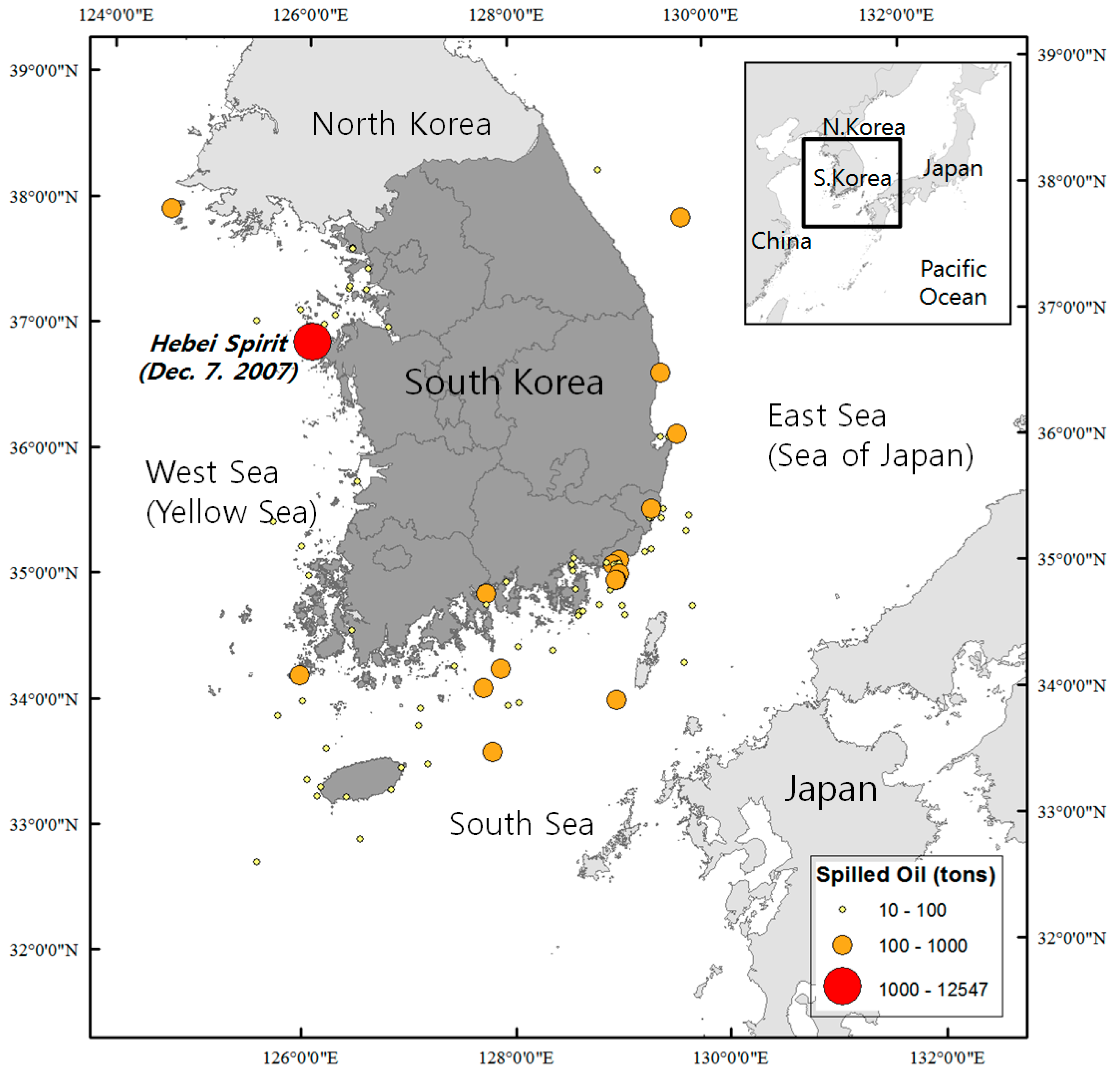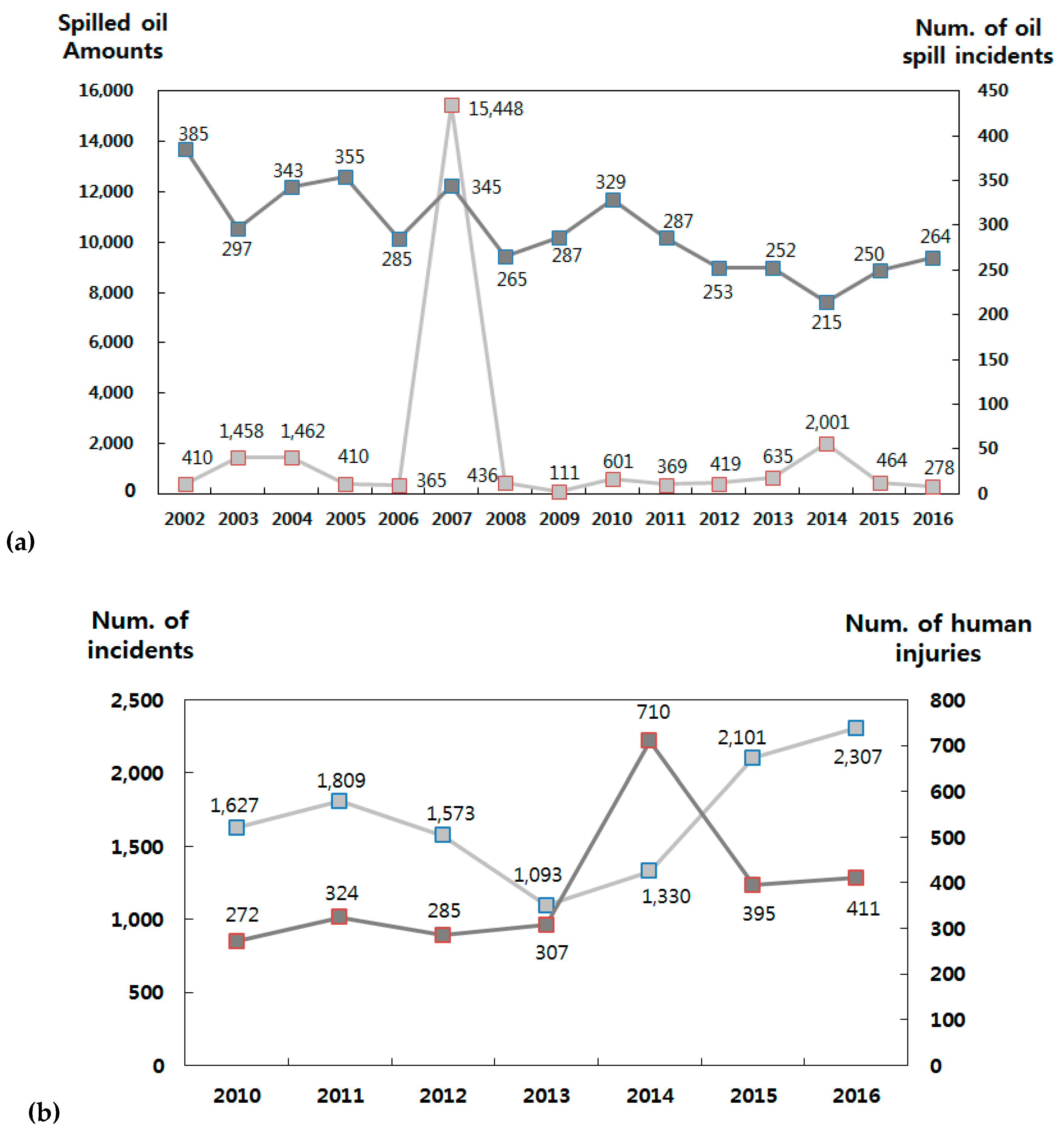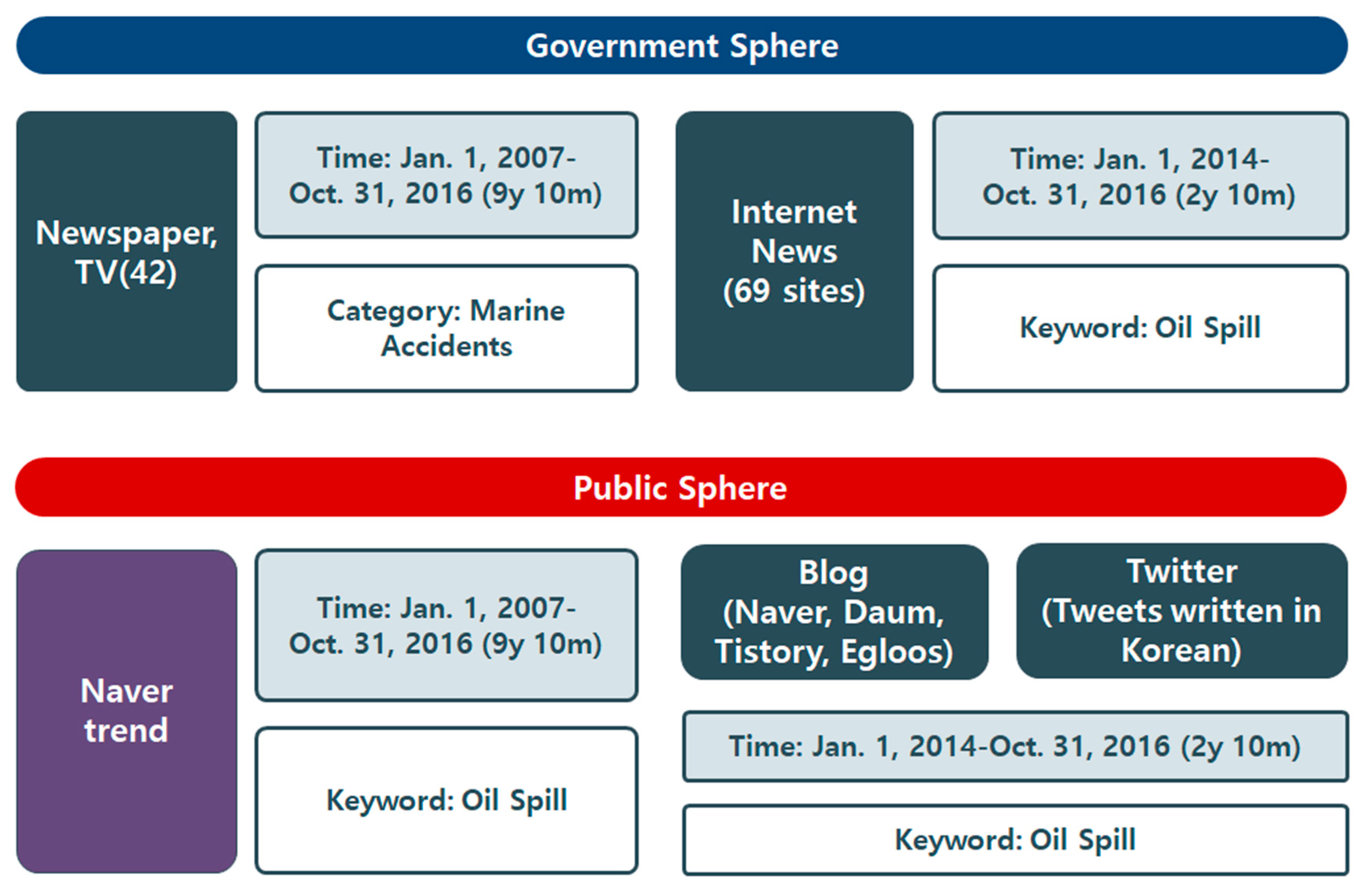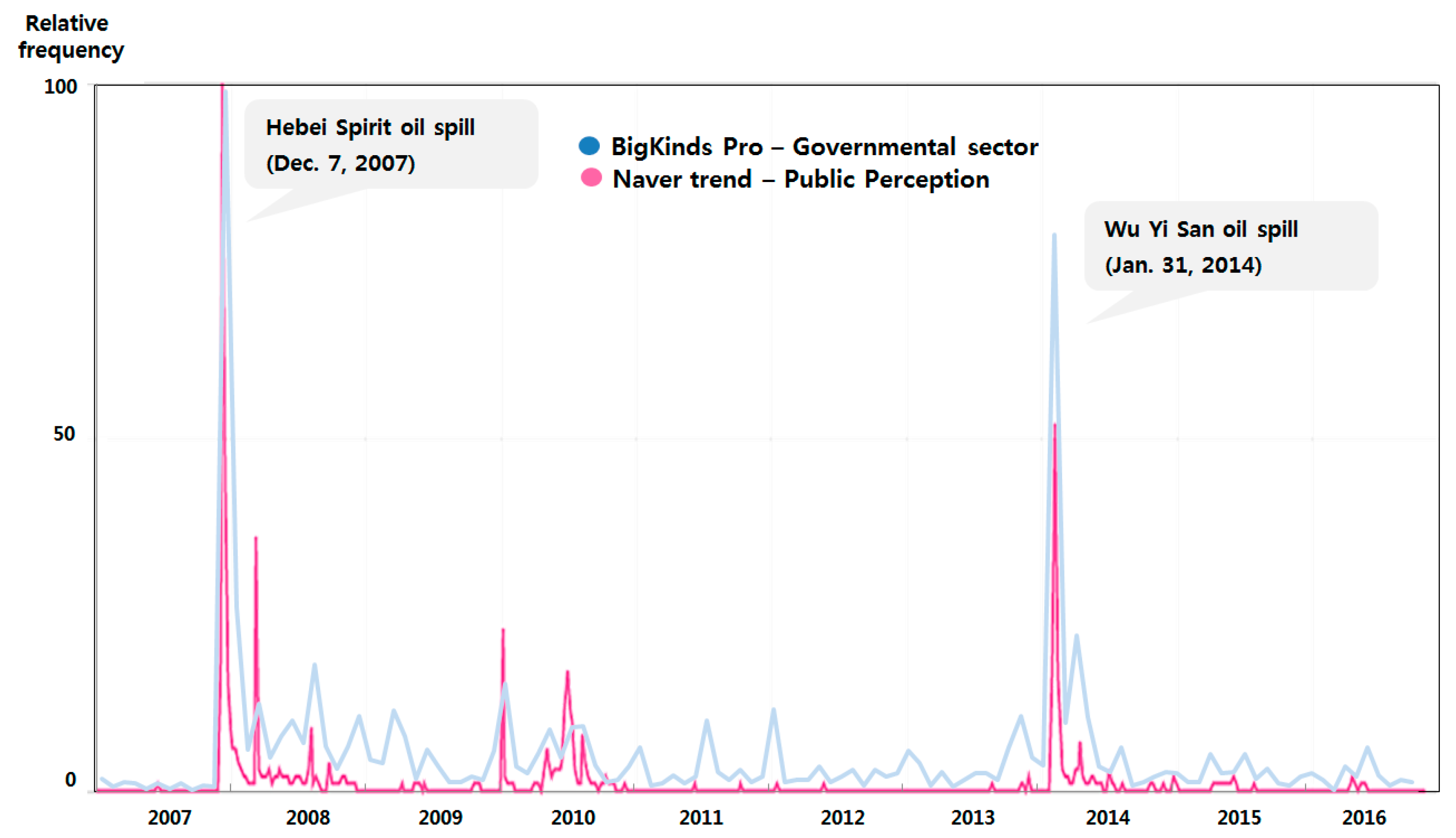Oil Spill Response Policies to Bridge the Perception Gap between the Government and the Public: A Social Big Data Analysis
Abstract
1. Introduction
2. Materials and Methods
2.1. Study Area
2.2. Data
2.3. Methods
3. Results
3.1. Keyword Trend Analysis of Oil Spill Incidents
3.2. Related Word Analysis
3.3. Negative Predicate Analysis
3.4. Original Text Analysis
4. Discussion
4.1. Public Perceptions of Oil Spills and Their Impact on Policy Implementation
4.2. Policy Agenda to Improve Public Perception of Oil Spills
4.3. Improving the Preparedness and Response System for Marine Pollution and Marine Disaster by Linking Social Science with Natural Science
5. Conclusions
Author Contributions
Funding
Acknowledgments
Conflicts of Interest
Appendix A
| Internet News (Governmental Sector) | Blogs and Twitter (the Public Sphere) | |||
|---|---|---|---|---|
| Rank | Keyword | Frequency | Keyword | Frequency |
| 1 | Yeosu-si (Yeosu city) | 1737 | Yeosu-si (Yeosu city) | 3718 |
| 2 | minister | 764 | minister | 2385 |
| 3 | incident site | 692 | Yun Jin-suk | 2319 |
| 4 | sea | 632 | Taean | 1942 |
| 5 | relevance | 624 | (disaster) prevention | 1604 |
| 6 | ocean | 598 | Taean peninsula | 1504 |
| 7 | occurrence | 563 | Samsung | 1419 |
| 8 | fishery | 555 | Taean-gun(Taean county) | 1312 |
| 9 | Caltex | 520 | hole | 1295 |
| 10 | GS Caltex | 513 | Taean oil | 1284 |
| 11 | GS | 507 | Busan Metropolitan City | 1248 |
| 12 | Yun Jin-suk | 483 | Caltex | 1198 |
| 13 | damage compensation | 407 | GS Caltex | 1198 |
| 14 | fishermen | 407 | GS | 1186 |
| 15 | Ministry of Oceans and Fisheries | 398 | sea water | 1128 |
| 16 | incident | 378 | fatal incident | 1081 |
| 17 | Jeollanam-do | 356 | incident site | 1051 |
| 18 | Busan Metropolitan City | 317 | fishery | 1049 |
| 19 | pollution damage | 307 | Ministry of Oceans and Fisheries | 1015 |
| 20 | residents | 286 | incident | 989 |
| 21 | offshore of Yeosu | 273 | It’s the same | 977 |
| 22 | damage control committee | 271 | sameness | 977 |
| 23 | controversy | 239 | article | 974 |
| 24 | control work | 225 | victim | 969 |
| 25 | minister of Ministry of Oceans and Fisheries Yun Jin-suk | 216 | Samsung Heavy Industries | 938 |
| 26 | countermeasures | 212 | industry | 938 |
| 27 | National Assembly | 204 | photo | 909 |
| 28 | government-ruling party consultation | 200 | event | 907 |
| 29 | support | 198 | South Regional Headquarters Korea Coast Guard | 887 |
| 30 | minister Yun | 198 | obstruct | 883 |
| 31 | Wu yi San | 187 | photo of Yun Jin-suk MOF minister | 880 |
| 32 | adequacy | 174 | substance | 869 |
| 33 | government | 168 | possession | 869 |
| 34 | area | 166 | substantial owner | 868 |
| 35 | member of the National Assembly | 166 | reason | 867 |
| 36 | Yeosu Coast Guard | 165 | Yeosu side | 865 |
| 37 | inappropriateness | 165 | others | 864 |
| 38 | president | 162 | others | 864 |
| 39 | statement | 159 | punishment | 861 |
| 40 | handling | 159 | adjudicate | 850 |
| 41 | on the sea | 156 | judgment | 847 |
| 42 | on this day | 154 | it’s a judge | 847 |
| 43 | this time | 150 | minister of Ministry of Oceans and Fisheries | 839 |
| 44 | visit | 150 | damage to fishermen | 787 |
| 45 | nose | 149 | minister of Ministry of Oceans and Fisheries Yun Jin-suk | 731 |
| 46 | safety | 146 | fire | 724 |
| 47 | victim | 141 | bomb terror | 703 |
| 48 | mouth | 137 | slip of the tongue | 693 |
| 49 | oil tank | 137 | Sewol | 684 |
| 50 | Crude Wharf | 136 | vehicle | 682 |
| 51 | oil tanker | 134 | coast | 676 |
| 52 | Saenuri | 134 | tourism | 674 |
| 53 | Saenuri Party | 131 | tourist | 674 |
| 54 | conference | 130 | guiltiness | 669 |
| 55 | commissioner | 127 | suspicion of rebellion | 668 |
| 56 | photo | 127 | Korea | 667 |
| 57 | sea water | 124 | president | 666 |
| 58 | police | 117 | Korean | 662 |
| 59 | people | 113 | large event | 657 |
| 60 | representative | 112 | collapse | 638 |
| 61 | reshuffle | 110 | marine life | 572 |
| 62 | Taean-gun | 109 | building | 556 |
| 63 | freight | 108 | responsibility | 555 |
| 64 | cargo ship | 108 | Jongno-gu | 549 |
| 65 | AI | 108 | auditorium | 545 |
| 66 | prevention | 107 | Sinai peninsula | 544 |
| 67 | Yeosu Industrial Complex | 105 | forgery of evidence | 541 |
| 68 | minister Yun Jin-suk | 104 | Seoul Metropolitan City | 541 |
| 69 | MOF (Ministry of Oceans and Fisheries) | 103 | Seoul spy case prosecution service | 540 |
| 70 | Crude 2 Wharf | 103 | prosecution service | 540 |
| 71 | response | 103 | body | 487 |
| 72 | lately | 100 | sea | 483 |
| 73 | oil | 100 | President Roh Moo-hyun | 481 |
| 74 | Yeosu Federation of Fisheries Cooperatives | 100 | death accident | 443 |
| 75 | fishery products | 100 | residents | 442 |
| 76 | words and actions | 99 | west coast | 423 |
| 77 | problem | 99 | minister of MOF (Ministry of Oceans and Fisheries) | 400 |
| 78 | Haeundae-gu | 98 | damage | 380 |
| 79 | Nakpo | 97 | attach | 380 |
| 80 | investigation | 96 | be devastated | 379 |
| 81 | relation | 94 | public sentiment | 379 |
| 82 | event | 93 | public sentiment worsened | 379 |
| 83 | damage | 92 | site | 373 |
| 84 | diffusion | 92 | Busan freight | 372 |
| 85 | environment | 91 | occurrence | 359 |
| 86 | reporter | 88 | Sewol ferry incident | 349 |
| 87 | birds | 86 | Shin Seung | 340 |
| 88 | words | 86 | Shin Seung-yong | 340 |
| 89 | work | 85 | West Sea | 340 |
| 90 | ship collision | 83 | Lee Soon-hyung | 336 |
| 91 | Nakpo-dong | 83 | assistant inspector | 336 |
| 92 | dismissal | 82 | assistant inspector Lee Soon-hyung | 335 |
| 93 | Shindeok village | 82 | nose | 330 |
| 94 | situation | 81 | diffusion | 322 |
| 95 | responsibility | 80 | At the time | 317 |
| 96 | pollution | 80 | Volunteer | 313 |
| 97 | cause | 78 | Industrial accident | 305 |
| 98 | Park Geun-Hye | 78 | Yoo Byeong-Eun’s family | 304 |
| 99 | blood | 77 | question thoroughly | 300 |
| 100 | BP (British Petroleum) | 77 | Lee Kun-hee’s family | 300 |
References
- Chang, S.E.; Stone, J.; Demes, K.; Piscitelli, M. Consequences of oil spills: A review and framework for informing planning. Ecol. Soc. 2014, 19, 26. [Google Scholar] [CrossRef]
- Li, P.; Cai, Q.; Lin, W.; Chen, B.; Zhang, B. Offshore oil spill response practices and emerging challenges. Mar. Pollut. Bull. 2016, 110, 6–27. [Google Scholar] [CrossRef] [PubMed]
- Knol, M.; Arbo, P. Oil spill response in the Arctic: Norwegian experiences and future perspectives. Mar. Policy 2014, 50, 171–177. [Google Scholar] [CrossRef]
- Cheong, S.-M. Community adaptation to the Hebei-Spirit oil spill. Ecol. Soc. 2012, 17, 26. [Google Scholar] [CrossRef][Green Version]
- Adger, W.N.; Hughes, T.P.; Folke, C.; Carpenter, S.R.; Rockström, J. Social-ecological resilience to coastal disasters. Science 2005, 309, 1036–1039. [Google Scholar] [CrossRef]
- Safford, T.G.; Ulrich, J.D.; Hamilton, L.C. Public perceptions of the response to the Deepwater Horizon oil spill: Personal experiences, information sources, and social context. J. Environ. Manag. 2012, 113, 31–39. [Google Scholar] [CrossRef]
- Oil Budget Calculator Deepwater Horizon Technical Documentation; The Federal Interagency Solutions Group, Oil Budget Calculator Science and Engineering Team, 2010; pp. 38–40.
- Brennan, K. A Stakeholder Analysis of the BP Oil Spill and the Compensation Mechanisms Used to Minimize Damage. Honors Thesis, University of South Florida, Tampa, FL, USA, 2013. [Google Scholar]
- Gulf Coast Ecosystem Restoration Council. 2017. Available online: https://www.restorethegulf.gov (accessed on 23 March 2020).
- Walker, A.H. Chapter 1 -Oil spills and risk perceptions. In Oil Spill Science and Technology, 2nd ed.; Fingas, M., Ed.; Gulf Professional Publishing: Boston, MA, USA, 2017; pp. 1–70. [Google Scholar] [CrossRef]
- Simon-Friedt, B.R.; Howard, J.L.; Wilson, M.J.; Gauthe, D.; Bogen, D.; Nguyen, D.; Frahm, E.; Wickliffe, J.K. Louisiana residents’ self-reported lack of information following the Deepwater Horizon oil spill: Effects on seafood consumption and risk perception. J. Environ. Manag. 2016, 180, 526–537. [Google Scholar] [CrossRef]
- Easman, E.S.; Abernethy, K.E.; Godley, B.J. Assessing public awareness of marine environmental threats and conservation efforts. Mar. Policy 2018, 87, 234–240. [Google Scholar] [CrossRef]
- Correa, T.; Hinsley, A.W.; de Zúñiga, H.G. Who interacts on the Web?: The intersection of users’ personality and social media use. Comput. Hum. Behav. 2010, 26, 247–253. [Google Scholar] [CrossRef]
- Bello-Orgaz, G.; Jung, J.J.; Camacho, D. Social big data: Recent achievements and new challenges. Inf. Fusion 2016, 28, 45–59. [Google Scholar] [CrossRef]
- Park, S. Characteristic of on-line newspapers as an alternative communication channel: A content-analysis of the Ohmynews. Korean J. Journal. Commun. Stud. 2001, 45, 117–155. (In Korean) [Google Scholar]
- Song, T.M.; Song, J.Y. Prediction of Threat Recognition factors relating to North Korea with Application of Social Big Data. Natl. Secur. Strategy 2014, 14, 209–243. (In Korean) [Google Scholar]
- Huh, M.-H.; Yoon, Y.-A.; Lee, Y.-G. Sample Distortion in Social Surveys and Effects of Weighting Adjustment: A Study of 18 Cases. Surv. Res. 2004, 5, 31–47. (In Korean) [Google Scholar]
- Kang, N.J.; Baek, Y.M. Sampling Bias of Internet and Mobile Phone Survey: Correctional Sample Balancing through Propensity Score Weighting and Iterative Proportional Fitting Method. J. Commun. Res. 2004, 41, 43–78. (In Korean) [Google Scholar]
- Noveck, B.S. Wiki Government: How Technology Can Make Government Better, Democracy Stronger, and Citizens More Powerful; Brookings Institution Press: Washington, DC, USA, 2009. [Google Scholar]
- Lee, G.; Kwak, Y.H. An open government maturity model for social media-based public engagement. Gov. Inf. Q. 2012, 29, 492–503. [Google Scholar] [CrossRef]
- Paul, M.J.; Sarker, A.; Brownstein, J.S.; Nikfarjam, A.; Scotch, M.; Smith, K.L.; Gonzalez, G. Social Media Mining for Public Health Monitoring and Surveillance. In Proceedings of the Pacific Symposium on Biocomputing, Big Island, HI, USA, 4–8 January 2016; pp. 468–479. [Google Scholar]
- Kopec, A.N. Recent Incidents Attended by ITOPF and Lessons Learnt; IMO OPRC-HNS Technical Group Meeting: London, UK, 2014. [Google Scholar]
- Statistics Korea. Marine Accident Statistics. Available online: http://www.index.go.kr/potal/main/EachDtlPageDetail.do?idx_cd=1770 (accessed on 23 March 2020).
- Ministry of Public Safety and Security (MPSS). Oil Pollution Statistics; MPSS: Sejong, Korea, 2017. (In Korean) [Google Scholar]
- Ministry of Public Safety and Security (MPSS). Introduction of Marine Pollution Control Work; MPSS: Sejong, Korea, 2017. (In Korean) [Google Scholar]
- Chung, M.G.; Kang, H.; Choi, S.-U. Assessment of coastal ecosystem services for conservation strategies in South Korea. PLoS ONE 2015, 10, e0133856. [Google Scholar] [CrossRef]
- Statistics Korea. Census of Agriculture, Forestry and Fisheries; Statistics Korea: Daejeon, South Korea, 2010. (In Korean) [Google Scholar]
- Statistics Korea. Changes in Coastal Wetland (Tidal Flat) Area. Available online: http://www.index.go.kr/potal/main/EachDtlPageDetail.do?idx_cd=1275 (accessed on 7 February 2018).
- Statistics Korea. Land Status 2017. Available online: http://www.index.go.kr/potal/main/EachDtlPageDetail.do?idx_cd=2728 (accessed on 7 February 2018).
- Ministry of Oceans and Fisheries (MOF). National Comprehensive Survey of Marine Ecosystem–West Sea and Western South Sea; MOF: Sejong, South Korea, 2015. (In Korean) [Google Scholar]
- Number of Mobile Phone Social Network Users in South Korea from 2013 to 2019. Available online: https://www.statista.com/statistics/429726/number-of-mobile-social-network-users-south-korea (accessed on 23 March 2020).
- Top 50 Countries by Smartphone Users and Penetration. Available online: https://newzoo.com/insights/rankings/top-50-countries-by-smartphone-penetration-and-users (accessed on 8 February 2018).
- Naver DataLab. Available online: http://datalab.naver.com/ca/step1.naver (accessed on 8 February 2018).
- 2015 Search Engine Market Share by Country. Available online: http://returnonnow.com/internet-marketing-resources/2015-search-engine-market-share-by-country (accessed on 8 February 2018).
- Maum.ai. Available online: https://maum.ai/login/loginForm?lang=en (accessed on 8 May 2020).
- Lim, H.; Rhee, J.W. The press’ utilization of the government’s press releases in Korea. Korean J. Journal. Commun. Stud. 2011, 55, 5–31. (In Korean) [Google Scholar]
- BigKinds. Available online: https://www.kinds.or.kr/main.do (accessed on 8 March 2020).
- Chowdhury, G.G. Natural language processing. Annu. Rev. Inform. Sci. 2003, 37, 51–89. [Google Scholar] [CrossRef]
- Yoon, B.; Park, Y. A text-mining-based patent network: Analytical tool for high-technology trend. J. High Technol. Manag. Res. 2004, 15, 37–50. [Google Scholar] [CrossRef]
- Perrow, C. Normal Accidents: Living with High Risk Technologies; Basic Books: New York, NY, USA, 1984. [Google Scholar]
- Moldan, G.S.; Jackson, L.F.; McGibbon, S.; Van Der Westhuizen, J. Some aspects of the Castillo de Bellver oilspill. Mar. Pollut. Bull. 1985, 16, 97–102. [Google Scholar] [CrossRef]
- Food and Agriculture Organization of the United Nations (FAO). FAO Yearbook of Fishery and Aquaculture Statistics; FAO: Rome, Italy, 2018; p. 9. [Google Scholar]
- Ministry of Land, Transport and Maritime Affairs (MLTM). A Study of Investigation of Impacts of Marine Pollution in Hebei Spirit Oil Pollution Accident and Restoration of Ecosystem; MLTM: Gwacheon, Korea, 2009. (In Korean) [Google Scholar]
- Ministry of the Interior and Safety (MPSS). Volunteer Activity White Paper—Hebei Spirit Oil Spill Clean-up Activity; MPSS: Sejong, Korea, 2008. (In Korean) [Google Scholar]
- Povlsen, E.; Hjorth, M. Technical Sub-Report 2: Environmental and Socioeconomic Vulnerability; BE AWARE, Bonn Agreement: London, UK, 2015; pp. 1–140. [Google Scholar]
- Beyer, J.; Trannum, H.C.; Bakke, T.; Hodson, P.V.; Collier, T.K. Environmental effects of the Deepwater Horizon oil spill: A review. Mar. Pollut. Bull. 2016, 110, 28–51. [Google Scholar] [CrossRef]
- Peterson, C.H.; Rice, S.D.; Short, J.W.; Esler, D.; Bodkin, J.L.; Ballachey, B.E.; Irons, D.B. Long-term ecosystem response to the Exxon Valdez Oil Spill. Science 2003, 302, 2082–2086. [Google Scholar] [CrossRef] [PubMed]
- Aguilera, F.; Méndez, J.; Pásaro, E.; Laffon, B. Review on the effects of exposure to spilled oils on human health. J. Appl. Toxicol. 2010, 30, 291–301. [Google Scholar] [CrossRef] [PubMed]
- Jeon, Y.-J.; Jang, B.-K.; Lee, I.-J.; Lee, J.-W.; Son, B.-S.; Cheong, H.-K.; Ha, M.; Choi, Y.-H.; Park, M.; Lee, S.-H.; et al. Impact of allergic diseases in elementary school students by the Hebei Spirit Oil Spill. Korean Public Health Res. 2016, 42, 57–68. (In Korean) [Google Scholar]
- Picou, J.S.; Marshall, B.K.; Gill, D.A. Disaster, litigation, and the corrosive community. Soc. Forces 2004, 82, 1493–1522. [Google Scholar] [CrossRef]
- Wu, Y.; Xie, L.; Huang, S.-L.; Li, P.; Yuan, Z.; Liu, W. Using social media to strengthen public awareness of wildlife conservation. Ocean Coast. Manag. 2018, 153, 76–83. [Google Scholar] [CrossRef]
- Vann, A.; Meltz, R. The 2010 Deepwater Horizon Oil Spill: Natural Resource Damage Assessment under the Oil Pollution Act. Congressional Research Service 7-5700. 2013. Available online: https://biotech.law.lsu.edu/blog/R41972.pdf (accessed on 29 August 2019).
- French-McCay, D.; Beegle-Krause, C.J.; Rowe, J.; Rodriguez, W.; Schmidt Etkin, D. Oil spill risk assessment: Relative impact indices by oil type and location. In Proceedings of the 32 AMOP Technical Seminar on Environmental Contamination and Response, Vancouver, BC, Canada, 9–11 Jun 2009; Volume 2, p. 940. [Google Scholar]
- Bolger, M.; Henry, S.H.; Carrington, C.D. Hazard and risk assessment of crude oil contaminants in subsistence seafood samples from Prince William Sound. In Proceedings of the Exxon Valdez Oil Spill Symposium, Anchorage, Alaska, USA, 2–5 February 1996; Volume 1996, pp. 837–843. [Google Scholar]
- IPIECA-IOGP. Sensitivity Mapping for Oil spill Response: Good Practice Guidelines for Incident Management and Emergency Response Personnel; IOGP Report Number 477; IPIECA-IOGP: London, UK, 2015; pp. 1–34. [Google Scholar]
- Petersen, J.; Michel, J.; Zengel, S.; White, M.; Lord, C.; Plank, C. Environmental Sensitivity Index Guidelines: Version 3.0; National Oceanic and Atmospheric Administration: Seattle, WA, USA, 2002; pp. 1–89. [Google Scholar]
- Reich, D.A.; Balouskus, R.; McCay, D.F.; Fontenault, J.; Rowe, J.; Singer-Leavitt, Z.; Etkin, D.S.; Michel, J.; Nixon, Z.; Boring, C.; et al. Assessment of Marine Oil Spill Risk and Environmental Vulnerability for the State of Alaska; National Oceanic and Atmospheric Administration (NOAA): Seattle, WA, USA, 2014; pp. 1–102. [Google Scholar]
- Murphy, D.; Gemmell, B.; Vaccari, L.; Li, C.; Bacosa, H.; Evans, M.; Gemmell, C.; Harvey, T.; Jalali, M.; Niepa, T.H. An in-depth survey of the oil spill literature since 1968: Long term trends and changes since Deepwater Horizon. Mar. Pollut. Bull. 2016, 113, 371–379. [Google Scholar] [CrossRef]
- Chun, J.; Kang, B.; Kim, C.-K. Comparison of Korea and World Marine Oil Spill Studies: Long-term Trend Analysis Through in-depth Literature Review. J. Korean Soc. Mar. Environ. Energy 2018, 21, 30–39. [Google Scholar] [CrossRef]
- Ministry of Public Safety and Security (MPSS). A Preemptive Study on Marine Pollution Response Caused by Environmental Changes such as International Ship Fuel Oil Regulation; Ministry of Public Safety and Security (MPSS): Sejong, Korea, 2017; pp. 1–112.
- Chun, J.; Kim, C.-K.; Ha, C. A Study on the Improvement of National Marine Pollution Response Policy according to Change of Marine Pollution Incident Trend. J. Korean Soc. Mar. Environ. Energy 2019, 22, 57–65. [Google Scholar] [CrossRef]
- Freudenburg, W.R.; Jones, T.R. Attitudes and stress in the presence of technological risk: A test of the Supreme Court hypothesis. Soc. Forces 1991, 69, 1143e68. [Google Scholar] [CrossRef]
- Teal, J.M.; Howarth, R.W. Oil Spill Studies: A Review of Ecological Effects. Environ. Manag. 1984, 8, 27–44. [Google Scholar] [CrossRef]
- Fingas, M. The Basics of Oil Spill Cleanup; CRC Press: Boca Raton, FL, USA, 2013; pp. 1–286. [Google Scholar] [CrossRef]
- Tamis, J.E.; Jongbloed, R.H.; Karman, C.C.; Koops, W.; Murk, A.J. Rational application of chemicals in response to oil spills may reduce environmental damage. Integr. Environ. Assess. Manag. 2012, 8, 231–241. [Google Scholar] [CrossRef] [PubMed]
- Huang, L.; Zhou, Y.; Han, Y.; Hammitt, J.K.; Bi, J.; Liu, Y. Effect of the Fukushima nuclear accident on the risk perception of residents near a nuclear power plant in China. Proc. Natl. Acad. Sci. USA 2013, 110, 19742–19747. [Google Scholar] [CrossRef] [PubMed]
- McKinley, E.; Acott, T.; Yates, K.L. Marine social sciences: Looking towards a sustainable future. Environ. Sci. Policy 2020, 108, 85–92. [Google Scholar] [CrossRef]






| Number of Commonly Mentioned Predicate | Number of Predicate Only Mentioned in Internet News | Number of Predicate Only Mentioned in Twitter/Blogs | |
|---|---|---|---|
| Positive | 1 (minimize) | 9 (prevent; prepare; be controlled; introduce; mobilize; block; investigate; reduce; sweet) | 9 (win; yes; recover; good; handle; progress; volunteer; guard; settle) |
| Negative | 7 (smell bad; be suspended; be forbidden; be polluted; devastated; suffer; not to know) | 12 (pollute; stop; spread; go crazy; be blocked; be ill; blocked; befall; be damaged; out of business; burn; poor) | 26 (unhappy; spread; abandon; take time; tremendous; disappear; tighten; burn; severe; inflict; change; pain; demolish; lose; scary; forget; commit; lose out; ruin; strange; die; collide; violate; collide; get exposed; fire) |
© 2020 by the authors. Licensee MDPI, Basel, Switzerland. This article is an open access article distributed under the terms and conditions of the Creative Commons Attribution (CC BY) license (http://creativecommons.org/licenses/by/4.0/).
Share and Cite
Chun, J.; Oh, J.-H.; Kim, C.-K. Oil Spill Response Policies to Bridge the Perception Gap between the Government and the Public: A Social Big Data Analysis. J. Mar. Sci. Eng. 2020, 8, 335. https://doi.org/10.3390/jmse8050335
Chun J, Oh J-H, Kim C-K. Oil Spill Response Policies to Bridge the Perception Gap between the Government and the Public: A Social Big Data Analysis. Journal of Marine Science and Engineering. 2020; 8(5):335. https://doi.org/10.3390/jmse8050335
Chicago/Turabian StyleChun, Joungyoon, Jeong-Hwan Oh, and Choong-Ki Kim. 2020. "Oil Spill Response Policies to Bridge the Perception Gap between the Government and the Public: A Social Big Data Analysis" Journal of Marine Science and Engineering 8, no. 5: 335. https://doi.org/10.3390/jmse8050335
APA StyleChun, J., Oh, J.-H., & Kim, C.-K. (2020). Oil Spill Response Policies to Bridge the Perception Gap between the Government and the Public: A Social Big Data Analysis. Journal of Marine Science and Engineering, 8(5), 335. https://doi.org/10.3390/jmse8050335






